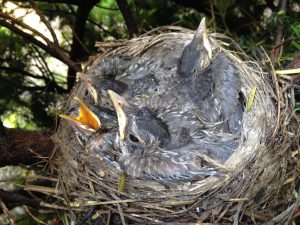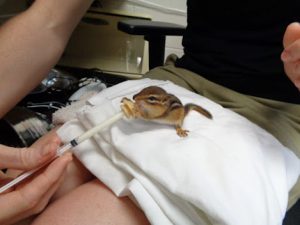Ohio Wildlife Center’s free Wildlife Hospital has grown to be a regional expert in wildlife rehabilitation during the past 36 years. Center veterinarians and the animal care team have developed specialized care and surgical procedures for a wide range of conditions — broken wings and limbs, cracked turtle shells and fishing tackle that is eaten or swallowed. The staff has mastered how to care for more than 150 different species, often preparing diets for up to 40 different species at a time.
“As a professional wildlife hospital, we’re really good at what we do,” said Casey Philips, hospital director, “but we’re always going to be the second best option compared to keeping wild animal families intact.”
In 2019, the Wildlife Hospital received more than 6,400 patients. Over one-third of those – more than 2,000 animals — were wild infants.
Buckets of opossums and squirrels, boxes of ducklings and whole nests at a time come through the Wildlife Hospital’s doors needing immediate care. But human care doesn’t compare to a wild mother’s care in the wild, Philips noted. Unless the animal parent is known to be missing or dead, healthy baby animals need to stay in the wild whenever possible, she said. Babies have the best chance of survival when fed natural diets by their parents and taught how to survive in their territory.
Wild Mothers Teach and Nurture Their Young
 According to Philips, wild mothers are the best at nurturing and guiding their young babies into adulthood. Some species, like raccoon moms, spend up to nine months teaching their offspring what is good or bad to eat, where it’s safe to live and how to navigate a human-dominated environment.
According to Philips, wild mothers are the best at nurturing and guiding their young babies into adulthood. Some species, like raccoon moms, spend up to nine months teaching their offspring what is good or bad to eat, where it’s safe to live and how to navigate a human-dominated environment.
The Center now receives thousands of calls and emails each year from people who have found a shallow nest of bunnies in their grass when mowing, or fledgling birds on the ground that look helpless, and ducklings searching for water. Many times, these wild animals are exactly where they are meant to be, but at times they need help to return to their nest. Philips noted there are things people can do to determine if human intervention is necessary before they act to remove or displace a baby animal.
“Babies found alone may be displaced from their parents, but that doesn’t always mean they are orphaned,” she said. “Wild parents are just as committed to their young as we are, if they are available they will return. Oftentimes, the family just needs a little help reuniting.”
If you find a young animal alone in your yard or neighborhood this spring, the Ohio Wildlife Center website can help identify the important factors in the situation and offer some solutions. Philips noted that if people are concerned that a wild infant is in distress, they should first confirm that it is uninjured.
For the initial assessment, go to: https://www.ohiowildlifecenter.org/help-wildlife/found-an-animal/ and ask the following questions:
Does this animal need my help? It needs a hospital visit if you answer yes to:
- Did my dog or cat bring it to me?
- Is it bleeding or does it have an obvious broken limb or other injury?
If possible, locate the animal’s nest and monitor the activity. If the animal does not have bleeding or obvious injury, you can help it the most by identifying where it came from, where the nest may be and trying to get it back in the nest. If it’s a bird, look up – was it a windy day? Do you hear or see frequent bird activity (parent birds will feed their young numerous times an hour during daylight). If it’s a rabbit, do you see a nest of high grass and rabbit fur nearby? Good reuniting techniques can help healthy wild babies get back to their parents after they have been separated or moved from within a natural nest or den.
It Is a Myth That an Animal Touched by a Human Can’t Be Put Back in the Nest
 When putting an animal back in a nest, it is important that you minimize contact so predators aren’t attracted to your human scent. But wild parents are great at recognizing their offspring. Some mammal species even have alternate nest sites available for moving their family to safety if their primary nest is compromised.
When putting an animal back in a nest, it is important that you minimize contact so predators aren’t attracted to your human scent. But wild parents are great at recognizing their offspring. Some mammal species even have alternate nest sites available for moving their family to safety if their primary nest is compromised.
The two most common reuniting situations are birds and bunnies. For both bird and rabbit nests, it is generally easy to put a stray young animal back into their nesting areas when possible.
For birds, it is common for baby birds to fall out of the nest. Because their bones are still developing at this time so the bird has less of a chance of serious injury from the fall. To help find the nest, look directly above where the bird was found or in the immediate surrounding area for trees or bushes to locate the nest. Some activity can provide a tip-off: male birds singing (territorial sign), chirping of other young birds begging for food, or adults flying in and out of certain trees or shrubs.
If the bird is featherless and appears uninjured, place the bird back into its nest or construct an artificial one if the original nest cannot be located or is too high. If the bird is mostly feathered with wispy feathers around its head, hopping around on the ground but not quite flying, it is likely a fledgling. These young birds are too big for the nest but spend up to two weeks on the ground being fed by parents while learning to fly and eat.
Sometimes an Artificial Nest is the Next Best Thing
 When assisting birds, if you can’t reach the nest or it has been destroyed, you can make a temporary nest with a plastic tub (margarine, sour cream tub, or green plastic baskets that contain raspberries or strawberries). Poke drainage holes in the bottom and fill the container halfway with pine needles or VERY dry, soft grasses to make a cup-shaped nest.
When assisting birds, if you can’t reach the nest or it has been destroyed, you can make a temporary nest with a plastic tub (margarine, sour cream tub, or green plastic baskets that contain raspberries or strawberries). Poke drainage holes in the bottom and fill the container halfway with pine needles or VERY dry, soft grasses to make a cup-shaped nest.
A baby bird cannot be left in a flat nest because its legs will splay outward and will develop improperly. Don’t use yarn or string to make the nest because the nestling or parents may become entangled in the yarn. Make two holes near the rim to wrap around the tree (the nest should be hugging the trunk of the tree). Tie it as near to the original nest site as possible, as high as possible, preferably in the same tree or bush. The wild bird parents should begin feeding the nestling as soon as they have located it through its chirping noises.
After placing the bird back in the real or constructed nest, watch the nest for 30-60 minutes to see if the parents are returning to feed the bird. If the adults haven’t returned within an hour, the bird is likely orphaned and should be brought to the Wildlife Hospital. Read more here: https://www.ohiowildlifecenter.org/help-wildlife/found-an-animal/helping-wildlife-birds/
Think Like a Rabbit When You Come Across a Baby Bunny Nest
 Because of the shallow and minimal nests that rabbits make for their babies, it is a common occurrence for bunny babies to be disturbed or discovered. The mother rabbits mainly visit their nests after dusk and before dawn to feed their babies so they don’t attract predators. Lawnmowers and pets are often the reason nests are uncovered.
Because of the shallow and minimal nests that rabbits make for their babies, it is a common occurrence for bunny babies to be disturbed or discovered. The mother rabbits mainly visit their nests after dusk and before dawn to feed their babies so they don’t attract predators. Lawnmowers and pets are often the reason nests are uncovered.
If a nest is disturbed and the babies are not harmed, they can be put back in the nest. Before dusk, sprinkle flour in a circle around the nest, using enough to make at least a two inch wide circle around the nest. At dawn, check the flour to see if there are rabbit prints.
If you see rabbit prints, it is likely the mother has visited her babies in the nest and is continuing to feed them. This is the preferred method to use when the weather is calm and dry. If there is no sign of the mother after using the flour method overnight, place the nest of bunnies in a small box and take them to Ohio Wildlife Center’s Hospital.
When Expert Help is Needed Call SCRAM! Wildlife Control
 If raccoons, bats or squirrels are discovered in an attic, expert wildlife technicians can assist through Ohio Wildlife Center’s SCRAM! Wildlife Control. SCRAM! is a paid service and technicians will inspect the attic, identify the type and number of animals present and create an eviction and exclusion plan. With squirrels and raccoons that are nesting in an attic or other space, SCRAM will evict the adult animal with a one-way door and then place the nest of young in a protected box near the entry point so the mother can collect her young and move them to a second nest site.
If raccoons, bats or squirrels are discovered in an attic, expert wildlife technicians can assist through Ohio Wildlife Center’s SCRAM! Wildlife Control. SCRAM! is a paid service and technicians will inspect the attic, identify the type and number of animals present and create an eviction and exclusion plan. With squirrels and raccoons that are nesting in an attic or other space, SCRAM will evict the adult animal with a one-way door and then place the nest of young in a protected box near the entry point so the mother can collect her young and move them to a second nest site.
Many traditional pest control companies euthanize young animals found in attics or other house or garage spaces, but SCRAM!’s certified technicians focus on humane eviction. This hands-off approach is a triple win – homeowners get a guaranteed exclusion, funds support the Center’s mission and the animals get a second chance at a wild life.
Limited services by SCRAM! Wildlife Control are still available during the COVID-19 pandemic. For more information call: (614) 763-0696.
